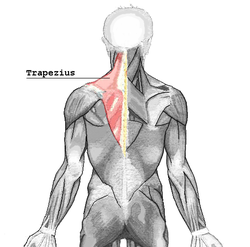- M. trapezius
-
Musculus trapezius 
Ursprung Protuberantia occipitalis externa, Nackenband, Dornfortsätze der Hals- und Brustwirbel Ansatz Schlüsselbein, Acromion, Schulterblatt (Spina scapulae) Funktion Bewegung des Schulterblatts Innervation Nervus accessorius und Äste des Plexus cervicalis Spinale Segmente C2-C4 Der Musculus trapezius (lat.: Trapezmuskel; seiner Form wegen auch Kapuzenmuskel oder Kappenmuskel genannt) verdankt seinen Namen dem Umstand, dass die beiden dreieckigen Einzelmuskeln der linken bzw. rechten Seite zusammen ein Trapez formen.
Inhaltsverzeichnis
Anteile
Der Muskel besteht beim Menschen aus drei Teilen:
- Pars descendens (lat.: absteigender Teil): der Teil oberhalb des Schulterblatts.
- Pars transversa (lat.: querender Teil): der Teil zwischen Brustwirbeln und Schultergelenk.
- Pars ascendens (lat.: aufsteigender Teil): der Teil unterhalb des Schulterblatts.
Bei den Haustieren unterscheidet man eine Pars cervicalis (Halsteil) und eine Pars thoracica (Brustteil).
Funktion
Die drei Anteile des Musculus trapezius sind verantwortlich für verschiedene Bewegungen:
- Pars descendens: das Heben des Schultergürtels, Kippen des Kopfes nach hinten und Rotieren des Kopfes bzw. der Halswirbelsäule zur Gegenseite
- Pars transversa: das Nachinnenziehen des Schulterblattes zur Wirbelsäule
- Pars ascendens : das Senken des Schultergürtels und Schwenken des unteren Winkels (Angulus inferior) des Schulterblattes nach außen
- Heben des Armes über die Horizontale
Klinik
Bei einer Lähmung des Musculus trapezius steht die kranke Schulter etwas nach vorn und tiefer. Der mittlere Rand des Schulterblatts (Margo medialis scapulae) steht schief von oben außen nach innen unten vom Rücken ab. Bei seitlicher Hebung des Armes kann dieser nicht bis zur Horizontalen geführt werden. Der Halt des Schulterblatts an der Wirbelsäule ist stark geschwächt und nicht mehr gesichert.
Varietäten
Gelegentlich kann der Musculus trapezius mit dem Musculus sternocleidomastoideus verwachsen. Diese Verwachsung erklärt sich aus der gemeinsamen Anlage der Muskeln, die daher auch beide vom elften Hirnnerv (Nervus accessorius) versorgt werden. Der dreieckige Spalt zwischen Musculus trapezius und Musculus sternocleidomastoideus, das seitliche Halsdreieck (Regio cervicalis lateralis), entsteht erst durch Trennung der gemeinsamen Muskelanlage.
Wikimedia Foundation.
